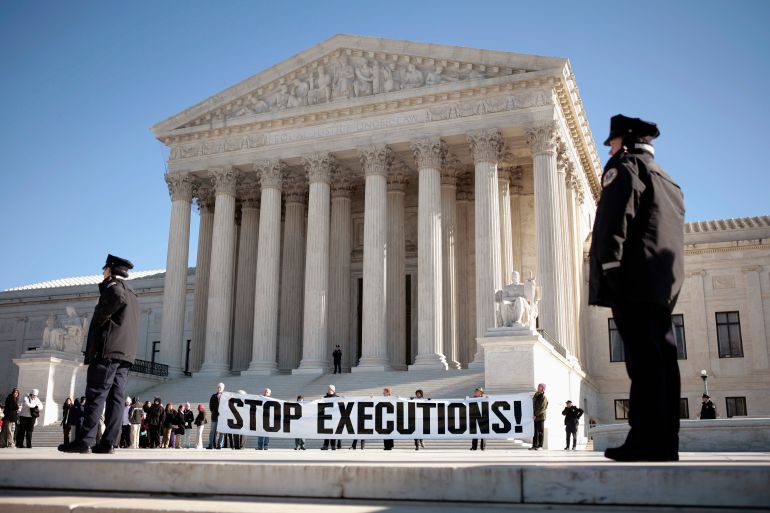Death by lethal injection: It is time for more transparency
An apparently botched execution in Alabama raises questions about the use of medicine as an arm of state power.

As a practising physician, I have studied the autopsies of executed prisoners in order to better understand how lethal injection actually kills. In July, the prisoner Joe Nathan James Jr was executed by the state of Alabama. The circumstances of that death raise troubling questions that are now sparking an outcry.
I know, because I carried out the autopsy that revealed what the state has not.
Keep reading
list of 4 itemsRecord number of people executed for drug offences in 2023
Executions in Iran hit 8-year high in 2023
Australian writer Yang Hengjun sentenced to death on China spy charges
Regardless of how one might feel about the rightness or wrongness of capital punishment, it still must comport with the law and not violate the 8th Amendment of the United States Constitution, which bars “cruel and unusual punishments.” Yet if accounts are true, James was subjected to a three-hour ordeal, as state officials attempted to establish intravenous access without any witnesses present. It is not possible to ask James to report on his experience but his bodily remains can still tell the story and guide us to the truth.
Execution is the killing of a person, and Alabama appears to acknowledge this by officially classifying executions as homicides and performing autopsies on every executed inmate. Yet the results of the state’s autopsy will not be available for many months – not because it takes that long to process autopsy results, but because Alabama is unwilling to publicly reveal what it knows. Alabama intends to carry out additional executions before the results of James’s autopsy are made public.
I was able to arrange a second autopsy with permission from the family, supported by the Forensic Justice Initiative at the non-profit civil rights organisation Reprieve. I travelled to Birmingham to try to satisfy the public need to understand the truth and hold accountable anyone who violates the law, even in the name of the law.
My examination of James’ body uncovered a story of great distress. I saw many failed intravenous puncture attempts on his arms and two perpendicular skin incisions on the left arm. These incisions appear to be attempts by the execution team to establish intravenous access through what is known as a “cut-down procedure”. In this procedure, a blade is used to slice deep into the skin and identify a vein by direct vision.
I found two slices on James, indicating that the first slice was unsuccessful. I cannot know if the second slice even found the vein as the catheter, if it had been there, was removed. In the hands of a skilled person, establishing two separate IVs in the arms, which is the state requirement for lethal injection, may take 10 minutes. Instead, the state appears to have stabbed, jabbed and twice sliced into the arm of James with a surgical blade for three hours.
When James was finally brought before witnesses for his execution, his eyes were closed and he was strangely unresponsive. The Department of Corrections has now said they “cannot confirm” whether James was even conscious. When I examined his body, I found unusual punctures on his skin which may have been intramuscular injections of a sedative. Such an intervention would be an unlawful act not permitted under Alabama’s execution protocol, and certainly not permitted as a medical act.
A toxicology report will eventually be available from the state autopsy which will tell us what drugs James had in his body when he was killed. I also obtained body fluid in order to study what drugs were used to possibly sedate and ultimately kill, and am awaiting the results.
In many ways, what Alabama appears to have done to James has parallels with Greek mythology – which also serves as a reminder of how the story of the modern autopsy owes its origins to antiquity.
Prometheus the Titan is said to have given the gift of fire and the skill of metal work to man thereby enabling progress and civilisation. Zeus, chief of the gods, was incensed and as a punishment had Prometheus chained to a rock where an eagle would eat out his liver every day only to have it grow back the following day to be eaten once more, in perpetuity. The agony was meant to last.
Those who wrote this ancient myth knew that the liver actually has the capacity to regenerate, unlike all other visceral organs. To figure this out would have required a series of careful post-mortem observations.
The second autopsy I conducted was needed only because the state of Alabama chooses to remain silent and hide information. The public demands to know the truth.
Civilised society requires more just punishments than daily devouring of the liver or successive slices into the flesh of the arm. The use of medicine as an arm of state power, or to inflict pain, is an anathema to the medical profession. Nothing good comes of this.
The views expressed in this article are the author’s own and do not necessarily reflect Al Jazeera’s editorial stance.
